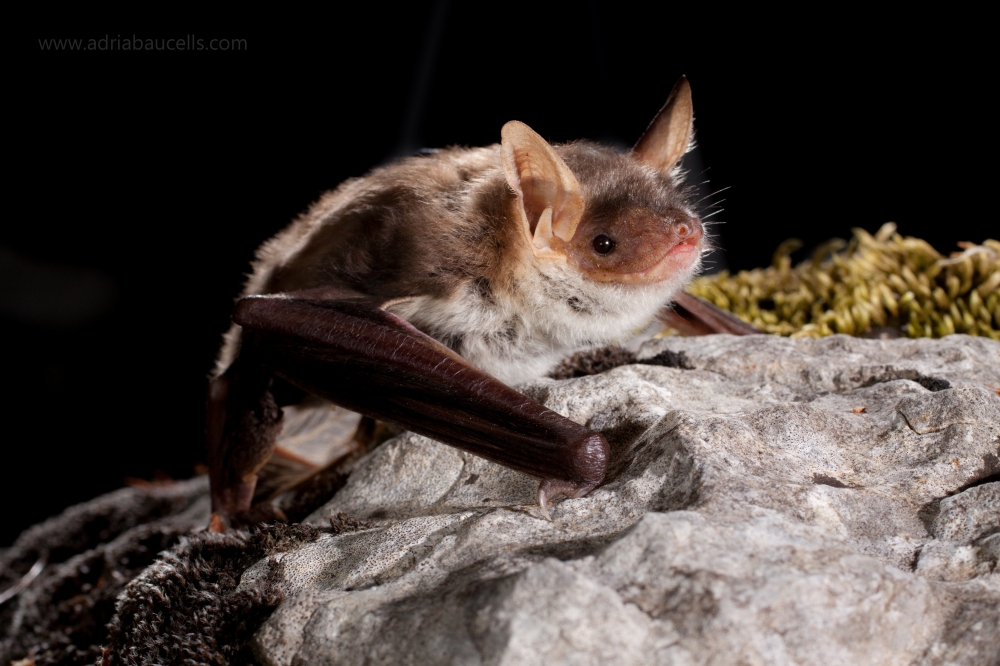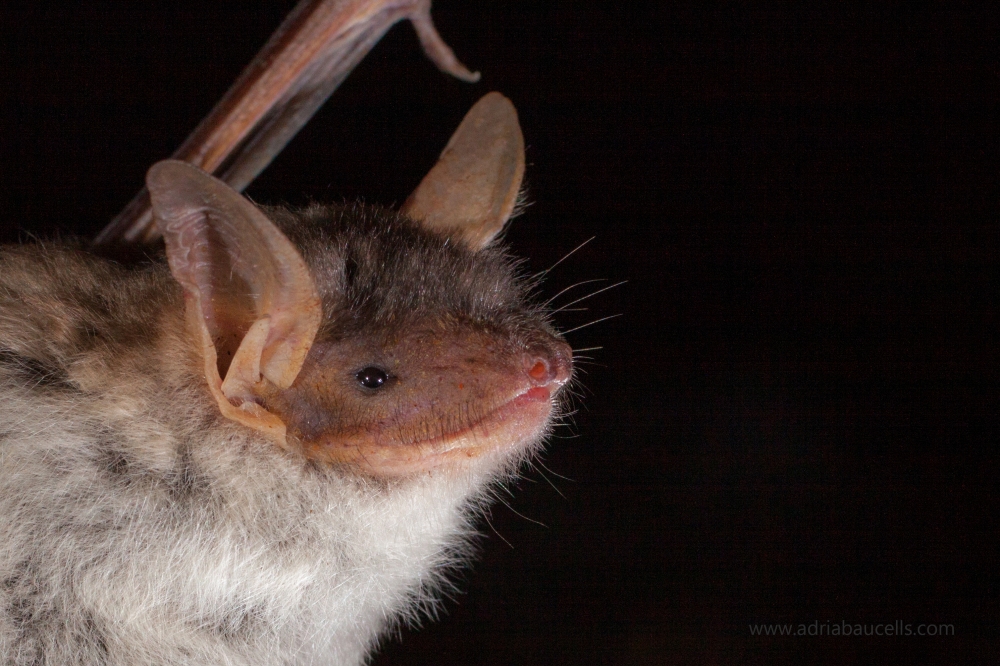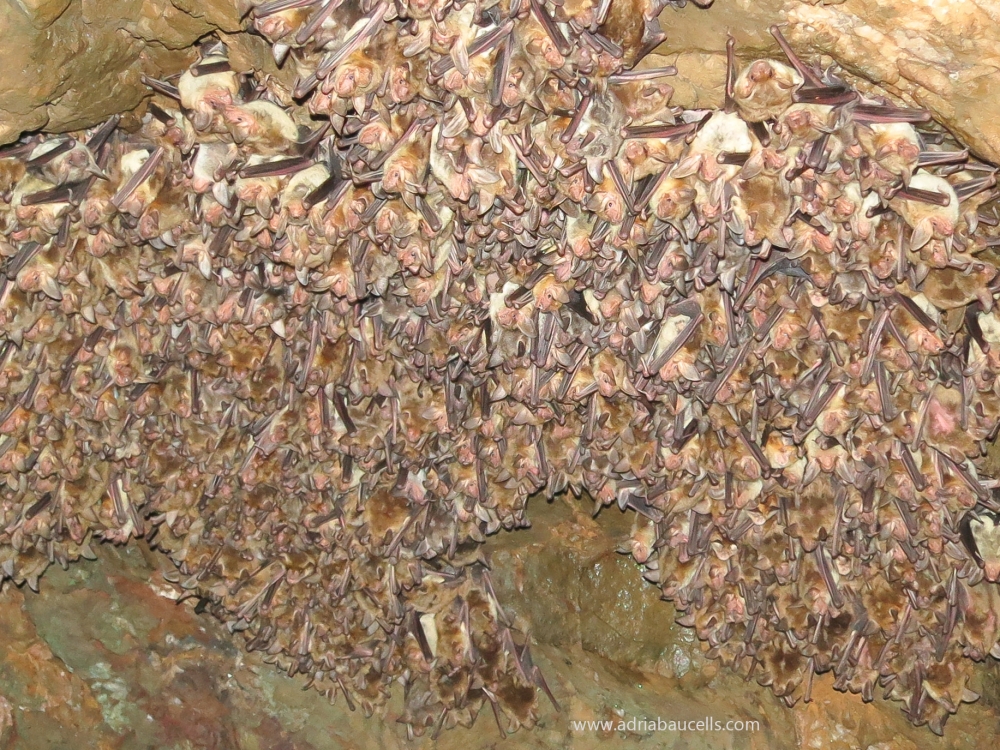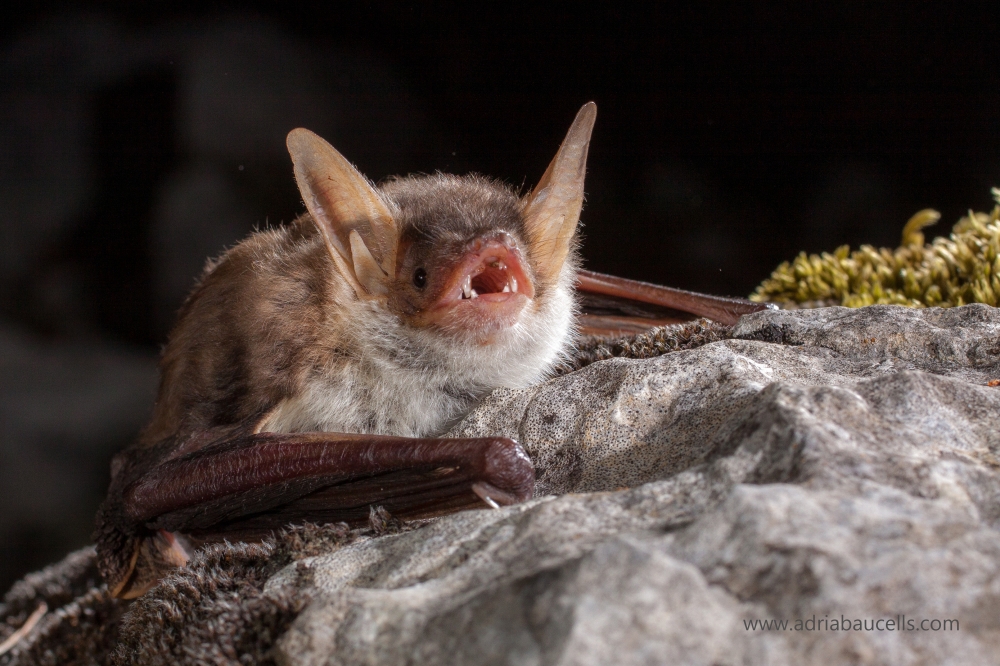Lesser mouse-eared bat
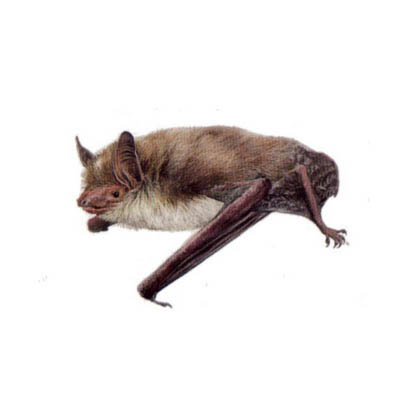
Myotis blythii (Tomes, 1857)
Vespertilionidae
Near Threatened
| Other names | |
|---|---|
| Catalan | Ratpenat rater mitjà |
| Spanish | Murciélago ratonero mediano |
| English | Lesser mouse-eared bat |
| French | Petit murin |
| Basque | Saguzar arratoi-belarri ertain |
| Galician | Morcego rateiro mediano |
Description
A large-sized mouse-eared bat, very similar to the greater mouse-eared bat (Myotis myotis), measuring between 54 to 76 mm in length (head and body), with a forearm of 50 to 62 mm, a wingspan of 390 mm, a tail of about 59 mm, and a weight between 19 and 26 g. This species typically has a dorsal colouration that is usually brown, contrasting with a ventral part that is yellowish, whitish, or grayish, usually lighter than the dorsal coloration. Some individuals of this species have a white spot on the forehead (between the two ears). Their ears are long (between 21 and 24.4 mm) and have a pale and pointed tragus.
It is distinguished from the greater mouse-eared bat by its shorter ears with fewer transverse folds (between 5 and 6) and the presence of a whitish hair spot between the ears (although this character is not found in populations in southeastern Europe). The possibility of hybridization between both species in adjacent areas makes their identification in hand very complicated. The ears of this species are usually shorter than those of the Felten's myotis (Myotis punicus).
Fotografies
Distribution
Its European distribution is concentrated in Mediterranean areas. Its distribution limits extend northward to central France, the northern part of Switzerland, the Czech Republic, Slovakia, and Ukraine. It is absent on the islands of Sardinia, Corsica, and Malta, as well as in northern Africa. It is widespread in the Middle East, as well as in Cyprus and Crete. To the east, it reaches the Caucasus and central Asia.
Roosts and phenology
Summer and breeding roosts in the northern part of their distribution are often found in buildings and attics, while in the Mediterranean region, they are almost exclusively found in caves and other underground cavities. Cave roosts are typically shared with other bat species, forming mixed colonies. In Slovakia, only four monospecific roosts are known; all others are shared with the greater mouse-eared bat. In Bulgaria, there is a breeding colony almost entirely composed of this species, consisting of about 8,000 individuals, although the more common scenario is breeding colonies with 50-500 females. Males of this species do not usually live in colonies but can form small groups near the main maternity colony. Pups are born from late May to mid-June. Births typically occur in May, with the second half of the month in Bulgaria. In Slovakia, births can occur from late May to early June. Females usually have one pup per year, and these start flying after 5 or 6 weeks of being born.
Mating usually occurs from August onwards, when males occupy mating roosts where they will defend small holes and cracks in cave ceilings and bridges. These micro-roosts are fiercely defended against rival males, and aggressive interactions can be observed often. Emitting loud mating calls, two to three (sometimes up to 6) females are attracted to form a mating group with the males. They do not typically undertake extensive migrations; they are considered non-migratory or occasional migrants. Typically, their hibernation roosts and maternity roosts are close, within a distance of 15 km from each other. During the winter, clusters of hundreds of individuals form in underground roosts.
Habitat and diet
This species is common in warm open areas with low vegetation such as meadows, flooded meadows, pastures, karstic areas, steppe landscapes, and agricultural zones. It can be found from sea level up to 2,100 meters in altitude, and its habitats may vary depending on latitude. It tends to avoid large closed forested areas, where the greater mouse-eared bat is usually more abundant. In Switzerland, they positively select unmown meadows, while in recently mown meadows, they only hunt immediately after mowing. The average distance between the roost and hunting points is usually between 4-7 km, with longer distances recorded ranging from 9-25 km.
Their diet consists largely of bush crickets (tettigoniids), as well as crane flies, ground beetles, grasshoppers, and mole crickets. In the Mediterranean region, they also consume praying mantises and caterpillars. Hunting flights typically occur at an altitude of 1-2 meters above the ground. Once they detect prey, they react quickly and capture it from the air or directly from the ground.
Echolocation
Its echolocation calls are very similar to those of Myotis myotis, showing large frequency changes between 120 to 170 kHz down to 26 or 29 kHz, with a duration between 2 and 10 ms. Like other large-sized mouse-eared bats, it is included in the Myotis 30 phonic group.
Status
According to the IUCN Red List, it is considered Near Threatened, with a negative population trend. This species is protected by national laws as well as the Eurobats Agreement, the Bern Convention, and the European Habitats and Species Directive. The decline in populations has been notable in recent decades in some locations, but it is considered stable in the northern part of its distribution; in Asia or Turkey, they are abundant. However, in Spain and Portugal, this species is considered rare and continues to experience a decline in its population. The loss of hunting habitats due to intensive agriculture, intensive plowing, and the transformation of steppe habitats into agricultural areas is one of the major causes of population decline in Eastern Europe and the Mediterranean. The other significant issue is the increase in disturbances in their natural roosts, especially in the Mediterranean region.
